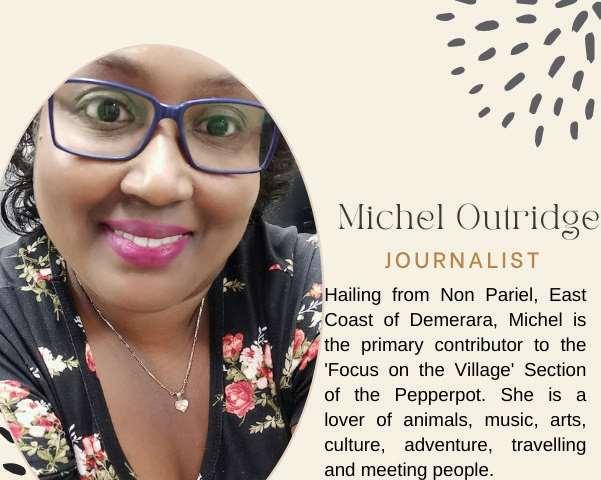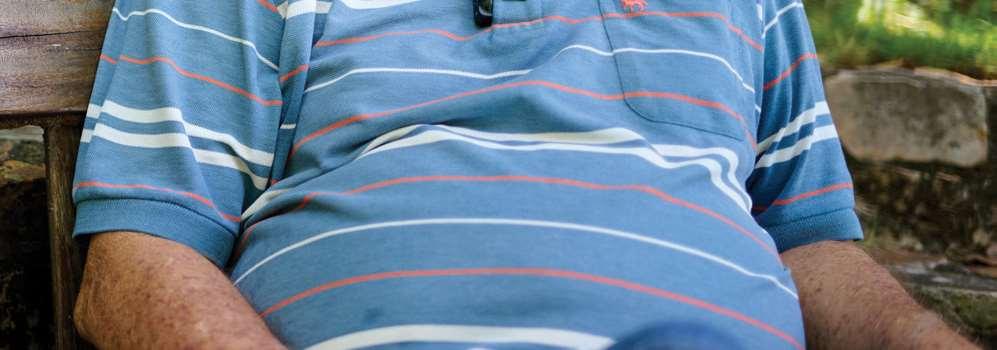






























WHENNigelJohnheard aboutatrainingprogrammeatIwokramaRiverLodgeandResearch Centre,hewasn’tconfidentenoughtoapply, butwithencouragement fromlocals,hedidand wasselectedtobecomea candidateforthetraining programmetobecomea certifiedForestRanger.
Havingonlyprimary educationasanativeof ApoteriVillage,aremote AmerindianSettlementlocatedbetweentheEssequibo andRupununiRiversin RegionNine(UpperTakutu-UpperEssequibo),John wasnotfortunatetobenefit fromsecondaryandtertiary education.
HetoldthePepperpot MagazinethatheisoriginallyfromShea,South Rupununi,butrelocated toApoteriVillagein1986 whenhisfatherworkedwith thethenbalatacompany. Heisfromafamilyofsix siblings,buttwobrothers havesincepassedaway, onelivesinBrazil,andtwo ofhisthreesistersresidein ApoteriVillage.
Hisparentslivewith him,andtheyenjoyaqui-
et,simplelifeinanaturalsettinginthebeautiful sport-fishingcommunity ofApoteri.Thefatherof sixstatedthatduetothe locationofthevillage,many thingswerenotaccessible. Assuch,hedidnotbenefit fromsecondaryeducation,
andhehadtoleaveschool aftercompletingprimary school.
Johnaddedthathewas alwayswillingtolearndespitechallenges,andhe wentintotrappingsongbirds,whichhesoldlocally forthreeyearstohavea
stableincome.Herelatedthat duringthattime,helearntof atrainingprogrammebeing offeredatIwokramaRiver LodgeandResearchCentre, buthedidn’tapply.

andIendured 22training coursesto becomeacertifiedForest RangerinGuyanafrom thelevelofconservationtosurvival,and Ihavebeenatthejob forthepast20years, sowithdetermination andthewilltosucceed anythingispossible,” hesaid.


Johnwasthenthe chairmanoftheCommunityWildlifeClub inApoteriVillage, whichhas40members, mostlyyouths,who weretaskedwithdata collectionandidentifyingbirds,trees,and fishinthecommunity.
Hestatedthatthey alsoparticipatedinculturalfestivalstopromotetheclubandto educatelocalsabout biodiversity.
JohntoldthePepperpot MagazinethatinApoteriVillage,thepopulationismade upoftheoffspringofthe Mucushi,WapishanaandPatamonatribes.Heexplained thatthelocalsearnviaparttimejobswiththeprivate touroperatorsasatourism destinationinsport-fishing ofarapaimainthe‘catchand release’methodsincetheydo notharvestthelargestfreshwaterfishintheworld.
Johnrevealedthatthe sportfishingseasonisfrom AugusttoMarchannually, butafterthisperiod,thelocals dependheavilyonsubsistence fishingandfarmingfortheir livelihood.
Hestatedthattheyhave severallodgesinthesurroundingvillages,whichprovide employmentforsomelocals, buttheywillsoonmakeApoteriVillageatourismdestinationbyopeningtheirvery ownlodge.
JohnnotedthatasaForest Ranger,hetravelledaround thecountryabit,andforhim, ApoteriVillageisthebest placetolivebecauseofthe naturalsetting,theabundance ofwildlife,andthesimplicity thatappealstohim.




Sometimelater,avillager encouragedhimtosendinan application.Helaterreceived aletterstatinghewasselected foraninterview,afterwhich hewasamongthecandidates fortheForestRangertraining programme.
“Itwasnoteasy;Ihadto applymyselftothefullest,
Hepointedoutthatduring theoff-peaksport-fishing season,jobsarenotalways withinreachinthevillage,and youthswouldhavetotravel tootherplacestosecureparttimejobsintheminingand loggingareas.
Johndisclosedthatthe constructionoftheproposed nameApoteriBalataLodgeis 95percentcomplete,andthey arehopingitwillbeofficially openedinNovember.
Henotedthatthelodge willbemanagedandoperated bythelocalsandwillprovide stableemploymentforsome andtheyarehopingtopromotetourisminthevillage.
JohntoldthePepperpot MagazinethatApoteriVillage isabeautifulplacethatisideal foreco-tourism.
TheApoteriresidentsaid theyhaveapackageoffering tours,etc.,topromotetourism andgenerateincomefortheir smallcommunity,whichhasa lottoexplore.
Becauseheisinvolved inmanythingsapartfrom beingaForestRanger,John reportedthatheusuallyhasa lotoftaskstocomplete,and soontheywillbeembarking ontheproductionofanother documentarythatpromotes sport-fishinginthevillage viathe‘catchandrelease’ method.
Asapoinofpride,John addedthatrecently,adocumentaryshotbyReel Guyana,whichhighlighted residents’rescueeffortsto savetrappedarapaimasin shallowwatersinApoteri Village,wasbroadcastin thevillageduringtheirmini heritagecelebrationinlate September.
ASwemoveintothemonthofOctober,hundreds ofwomenwillbeoutandaboutinpinktopromote breastcancerawareness,commonlyknownasPinktober.
Amongthemanystoriesthatwillbetoldthisseason, fewresonateaspowerfullyasthatofAnnaDeMorias, afour-timecancersurvivorwhosejourneyexemplifies courage,resilience,andhope.
Continuingtobealightforothers,Annaemphasises thatwomenshouldnotwait;dowhateverittakesto savetheirlives,andunderstandthatcancerdoesnot havetochangewhoyouareasaperson.Neitherdoes itdefineyou.
Beforeherinitialdiagnosis,Annaembodiedwhat societywouldconsiderthepictureofhealth.Adevoted mother,wife,andworkingwoman,shemaintainedan activelifestylethatincludedregular‘gym’sessions— furtherreinforcingthefactthatanyonecandevelopcancer.However,oneordinarydaywouldalterthecourse ofherlifewhenshediscoveredalumpinherbreast.
Despitehertypicallybravenature,Annahesitated beforeseekingmedicalattention,adecisionshenow reflectsonaslife-changing.“Iwaslivinganormallife, day-to-day,working,takingcareofmykidsandeverything.Iwasjustgoingtothe‘gym’onemorning,likeI alwaysdid,andwhenIcameback,Ifeltalumpbymy rightside.Igotscared,butIdidn’tgotothehospital rightaway.Itwasmonthslater,in2008,thatIfinally decidedtogetitchecked,andthebiopsycameback positiveforcancer,”shesaid.Thediagnosisrevealed StageThreecancer.
Thedecisiontohaveherrightbreastremovedwas adifficultone,butAnnamadetheboldchoicetosave herlife.“Iwasn’tcryingornothingwhentheytoldme Ihadcancer.Itoldmyfamily,andeverybodywasthere forme.Youknow,Ihadtohavesurgery,andthenlater,Ihadninemonthsofchemotherapy,”sheexplained.But thatwasjustthebeginningofalonganddifficultbattlewith
cancer,asitwouldlaterappearinherlungsandleftbreast. Wheninitiallygivenagrimprognosis,Annarefusedto acceptdefeat,andsoughtoutotheravenues.“Ididn’tgive up,though.IwenttotheCancerInstitute,andtheytoldme itwas50-50.ButIhadfaith,andIsaid,‘It’sinGod’shands now.’Istartedchemotherapyagainat‘Mercy’,andthenat




AgroupofsurvivorsgatheredinGeorgetownforatree-wrappingceremony.Amongthem,Anna (DelanoWilliamsphotos)
the‘PublicHospital’.Ninemonthsof‘chemo’,andImadeit through.”However,herbattlewasfarfromover.“Butthen, in2015,Ifeltanotherpaininmybreast.Iwentstraighttothe hospital,andtheydidanother biopsy.Itcamebackpositive again;Cancer!Ididn’twait
ByShaniyaHarding.
EVERYSeptember,Guyanacomesaliveincelebration ofAmerindianHeritageMonth.Asamulticulturalmeltingpot,thenationembracesthisvitalpartofGuyanese culturewithpassionandauthenticity—untilSeptember returnsthefollowingyear.
AnseliaRanny,ownerof‘PrettyLocal’,istakingitastep furtherbycelebratingwhatisotherwiseaseasonaloccasion year-round.Inthelastfiveyears,herbusinesshasemerged
asoneofthefewplaceswherepeoplecanexperienceAmerindiancultureanydayoftheyear.
Anselia’sheritageisintegraltoheridentity.Bornand raisedinthevillageofKamaranginRegionSevenofGuyana, shegrewupalongsidetheCuyuniandMazaruniRivers.Reflectingonherupbringing,shestates,“I’mfromtheAkawaio tribe.Webasicallygrewuponhunting,fishing,farming.”
WhenAnseliafoundherselffarfromhome,shesoughtout thetraditionalfoodsheknewandloved.Initially,hercooking wasawaytofeelclosertohome,andteachherchildrenabout



theirculture.Shebeganseekingouthard-to-findingredients, withrarefishandstaplessuchasfarinebeingchallengingto obtain.AswordspreadaboutthewomancookingIndigenous dishesinVryheid’sLust,hercustomerbasegrew.Withthe supportoffamilyandfriends,manyofwhomfellinlove withthetastesofRegionSeven,sheopened‘PrettyLocal’ fiveyearsago.
AtPrettyLocal,customerscanfindanauthenticsliceof Amerindiancuisineeveryday.“Ibasicallysellfreshlocal products,seawaterfish,andIndigenousstaples.Ialsomake tumapotorpepperpotonweekends.ButInormallyopen businesseveryday...Everyday,weopenfrom6o’clockto8 o’clock,”Anseliaexplains.
ThejourneytoestablishingPrettyLocalwasn’tjustabout business;itwasaboutfillingavoidinthecommunity.“When Icameouthere,therewasnoplacesellingthesefoods.I knowaboutPrincesStreet,butthentogothereisalong distance.So,Idecidedtomakemyown‘tumapot’,”Anselia recalls.Withencouragementfromherhusbandandfamily, whatstartedasasmallventurequicklygainedpopularity. “Westartedoffverysmall.Andthenweendedupgettinga lotofpeoplecomplimentingmy‘tumapot’.”
TheauthenticityofPrettyLocal’sofferingshasattracted customersfromacrossGuyana.“Wehavealotofpeoplefrom differentregions.Actually,almostalltheregionsjustcome heretosupport,”Anseliasaysproudly.Word-of-mouthhas beenherbestadvertisement,withsatisfiedcustomersbringingfriendstoexperiencetheuniqueflavours.“Evenpeople fromouthere,afriendwouldbringthemandsay,comeand trythis.Andwhentheycome,theytasteitgood.Youwould seethem.Theotherweek,theywouldcomeback.”
Anselia’scommitmenttotraditionalcookingmethodssets herapartinaworldofshortcutsandsubstitutions.Oneofher specialitiesistumapot,anIndigenousdishmadewithfish boiledincassavabroth.Whendescribingherpreparation,she emphasisessimplicity.“Whenmakingmytumapot,Imake itnaturally.Idonotaddanyotherstuff.Ijustusethis:The cassavawater,thepepper,andthefish.That’sall.Andsalt.” Thisdedicationtoauthenticityisn’tjustabouttaste;it’sabout respectingtraditionalpractices.
Anseliarefusestocompromisewhensourcingherproducts.She’sparticularlydiscerningaboutthefamedtraditional drink,‘piwari’.Inrecentyears,therehasbeenadeclinein theauthenticversion.“Now,youhavetowaitmonthstoget yourpiwariifyouwantthelocalpiwari.They’resellingalot ofpiwari,buttheyareverydifferentfromtheonewemake; notthetraditionalone,”sheexplains.
PrettyLocalisn’tjustsellingmeals;it’sprovidinganed-
ByMichelOutridge
BEINGaspeedboatcaptainisnosmallfeat.In fact,theundertakingis quitedangerous,andJames McGarrell,betterknown as“Calvin”,iswellaware ofthis.McGarrellmust beawareofthetidesand weatherconditionsatall times,andmustimplement safetyaspartofhisoperationstokeephimselfand hispassengerssafeand preservelife.
McGarrellisanativeof Parika,EastBankEssequibo,andstillresidesinthe community,aplacethatis familiartohim.The63-yearoldisfarfromhangingup hisgloveswhenitcomesto workasaspeedboatcaptain. Hehasspentmorethan40 yearstraversingtheEssequiboRiver,andheknowsall thenooksandcrannies,and justabouteverycornerin thatriver.
Sincehewasaboy,he hasbeengoingtothebeach inParika,whereheused tositandwatchtheboats andtheiroperators.Back then,thelocationcontaineda structurejustliketheseawall, butthathaslongwashed away.McGarrelltoldhimself thatonedayhewouldbecomeaboatcaptain,because hewouldvisittoobserve themenandtheirboatsday afterday.
Hewantedtobejustlike them.Helikedthewaythey masteredtheboat,andthey seemedtobeintotalcontrol.
Forhim,itlookedso easy,andhetookalikingto it.Heembeddedtheideaof becomingaboatcaptainin hismind,andhegrewwithit.





Whenhewasoldenough, atage15,hemadesurehe wasaroundtosecureajob withboatownersandboat captains.
Fromdoingoddjobsat ParikaStellingtobecoming aboatcaptainwasalongand hardjourneyforMcGarrell, whoseonlyconsolationwas thatonedayhewouldfulfill hisdream.
“IwasattheParika Stellingworking,willingto learn,andIgainedknowledgefromaformerboatcaptain,thelateFloydGriffith, whohadhisownspeedboat,
andafterhepassedaway,I wenttoworkwithothers. Astimewentby,Ibecame licensed,becauseitwasthe rightthingtodo,andfrom there,Iwasabletomasterthe jobofbeingaboatcaptainon myown,”hesaid.
EventhoughMcGarrell doesn’townhisownspeedboat,heworkswithJustinChance,whoownsfour speedboatsthatplytheParika toSupenaamroute.
McGarrelltoldthePepperpotMagazinethatthe boatsareoutfittedwithindividualcushionedseatsfor22, 21,19and20passengers,respectively.Allofthevessels havesheds,andthenecessary safetygear,includinglife jackets,whichmustbeworn.
Thefatheroffiveand grandfatherofsevenstated thathebeganworkingwith boatswhentheyweresmall andhadnoshedsliketheydo now.Backthen,aboatwas just10to15dollars.
Growingup,McGarrell’s optionsforemploymentwere verylimited,sincehewas forcedtoleaveschoolearly. So,apartfromlikingthe profession,itwasalsooneof theonlyoptionsinlife.Even thoughitwasnoteasy,he reportedthathelearnedalot andgainedexperienceover theyears.
Herelatedthattwolicencedtouroperators,TouringGuyanaandDagron


JamesMcGarrelldoingwhathelovesbest,at thewheelontheEssequiboRiver
Tours,wouldhireboatsfor tripsintheEssequiboRiver togotoresorts,heritage sites,waterfalls,andother placesfortheday.McGarrell
pointedoutthatthisisnot everydaywork,butattimes, theywouldgetafewtrips perweek,andhegetspaid fortheday,basedonthetrips
andpricesperhire.
Headdedthathelikeshis job,becausehegetstomeet manypeoplefromallover theworld;touristsandalso ourlocalpeople.Andhegets toshowthemourbeautiful Guyana;somethingheis veryproudof.
McGarrellsaidthatas partofhisjob,hewouldtell peopleaboutGuyana,andas aseasonedboatcaptain,heis familiarwithmanyplaceson theEssequiboRiver.
Herelatedthathenever getstiredofvisitingthe sameplacesoverandover again,andsomeofthemost visitedplacesincludeFort Island,SlothIsland,Bartica,Aruwai,Baganara,and FortKyk-Over-Al,among others.
ByShaniyaHarding
BEYONDthebrightlightsofGeorgetown,Guyana’s capitalcity,lifethroughoutthecountry’svastnessdiffers
fromplacetoplace,eachcommunityuniqueinitsown way.Yetthepursuitofeducationremainsuniversal,with womenlikeMarlynBrownleadingthewayaschampions oflearning.
Theteacherandmotheroffivesaysthatcomingfroma single-parenthomeshowedherthatwomenarecapableof morethantheyknow.Nowpursuingherbachelor’sdegree, Marlynhopestopavethewayformorewomentopursue greaterpursuits.
Beforebecomingtheinspirationalpowerhousesheis today,Marlyngrewupinafamilyofseven,withfivesisters andthreebrothers.Thiswaswhereshegainedherambition, watchinghermotherworkforherfamilyandraisesuccessful children;Marlynwasmotivatedtotakeitonestepfurther.Reflectingonhermother,shestates,“Mymomhelpedfinancially.Shewasneversomeonewhowassittingtherewaitingfor things;shewouldgoouttheretowork.Whatsheusedtosay isthatyouhavetostudy;youhavetoeducateyourself,and youhavetoworkforyourownmoney.Nobodyisgoingtoput thingsinyourpocket.Youhavetodoit;youhavetogetit.”
Aftercompletingschool,Marlyn,likemanyyoungwomeninhercommunity,facedlimitedcareeroptions.Following heroldersister’sadvice,shepursuedteaching,oneofjusta fewchoices.“Youwouldhaveknownthatafteryoucomplet-
MarlynBrown,teacher,motherandwife,currentlypursuingherbachelor’sdegree(Samuel Maughnphoto)
edyourCXC,youcanbecomeateacher,youcanbecome apoliceofficer,youcanbecomeanurse,”sheexplains.“I hadtwoothersisters.OneofthemwenttoBrazilwhenshe hadn’tcompletedherwork.Theotheroneisateachernow; aqualifiedteacher,too.Growingup,Ihadtwoothersiblings thatIwouldlookafter.”
Afterbecomingateacher,Marlynfeltinspiredtodo more.SheundertookatrainingcoursewiththeBoardof IndustrialTraining.Althoughasimpleventure,itsparked herenthusiasmforlearningnewskillsshecouldbringback tobothhercommunityandclassroom.“I’mateacherat theprimaryschool,completedmyteacher’straining.Ialso didaprogrammewiththeBoardofIndustrialTrainingand CommercialPreparation,whereIlearnednewskills.Thishas beenveryhelpfulinmyclassroom,Ihavefoundittobevery helpful,inthatyoudothepracticalpartofteaching,andthen thetheory,you’llbebetterabletoexplain.”
Marlyniscurrentlypursuingabachelor’sdegreeonline intheheartoftheRupununi. Butshedoesnotplantostop there;herdreamistobepart
ByShaniyaHarding
THERockViewLodgeisawell-knownnameamong natureloversandfrequenttravellersoftheRupununi. Thebeautifulassortmentoflodges,amongthetreesand surroundedbymountainsandreddustoftheregion, makesRockViewperhapsoneofGuyana’smostattractive touristdestinations.
seemtohavebecomeonewiththeneighbouringdarkgreen foliage.
ThisisbecauseRockViewisapartoftheRupununi,built amongthetrees.RockViewhasasustainableandenvironmentally-safeapproach,withallnaturalavenueshavingbeen explored.“Theprimeobjectiveisthatournichemarketisfor communitytourismbenefitbesides,ofcourse,protectingthe biodiversityofourrainforest.”




ColinEdwards,FounderofRockViewLodge (SamuelMaughnPhotos)
ButhundredsofpeoplehaveventuredtotheRupununi escapeformorethansightseeingandatasteofGuyana.
FoundjustoutsideofAnnai,RockViewwasbuiltonthe principlesofsustainabilityandfamily.CraftedbyEnglishman ColinEdwards,RockViewLodgehasbeenredefiningtourismintheregionformorethanthirtyyears.
BorntoaWelshfatherandaBasquemotherinpost-World WarIIEurope,Colin’schildhoodexperiencesshapedhis futurepath.Nostrangertodiversityandtravel,Colinwas taughttheimportanceofpeopleandplaceatanearlyageby hisparents,whowerefrequenttravellersthroughoutEurope.
Theseearlyyearsoftravelling,meetingnewpeople,and havingnewexperiencesiswhathesayswouldlatercaptivate himaboutGuyana.Ashestated,“Asachild,wewouldtravel tofarawayplacesandstayinhumblelodges,farmhouses, vineyards,butneverinbighotels.Myparents’lovewasfor themountains,thelakedistrict,thefarmsoftheIsleofSkye, andthiscreatedinmeanunderstandingofthevalueofbeing incontactwithnatureandthepeoplewholiveinanatural environment.”
ThejourneytoGuyana
EdwardsarrivedinGuyanain1969asavolunteer.Young andadventurous,hecametotheLandofManyWaterswith purpose.AlthoughhavingspenttimeincountrieslikeGermany,Peru,andPanama,Guyanaseemedtohavesomething specialaboutit.WhetheritwastherollinghillsofthesavannahorthewarmthoftheGuyanesepeople,Edwardssoon decidedtosettledowninGuyana.
Hewasnotcaptivatedbyjustthesights,sounds,and tastes;however,ColincameasapartofGuyana’searly agriculturalventure.“IcametoGuyanain1969asaVSO withVoluntaryServiceOverseastoworkwiththeMinistry ofAgricultureintheNorthwestDistrictofGuyanawiththe objectiveofsettlingfarmersthroughthecooperativesystem toinvolvethemselvesinagriculturalactivities,”hesaid.
BuildingRockViewLodge
HisvisionforRockViewLodgewasclearfromthebeginning.Hehadvisitedhotelsandlodgesaroundtheworld, andhewantedtocreatesomethingdifferent.Oneofthethings thatisstrikingabouttheRockViewLodgeishowintuneit appearswithnature.Aseriesofsmalllodgesandbuildings
Edwardsrecognisedtheneedforeconomicdiversification inIndigenouscommunitiesaswell.Oneofthereasonsthat RockViewhasbecomesuchabigpartoftheregionisits involvementwithlocalcommunities.Colinandhisfamily workalongsideAmerindianstobetterunderstandtheland andregion.
Thishastranslatedintopeoplefromthesurrounding areasworkingwithRockViewLodge.Colinseestourism, specificallyagro-tourism,asoneofthebestwaystobuild anddiversifytheeconomiesofRupununicommunities.“Our Indigenouspeoplelivealifestyleofsubsistencethrough farming,hunting,andfishing.Whatwehavelearnedinthe Rupununiisthatagricultureandtourismarethemainsustainableeconomicactivities,”hesaid.
Afamilyapproachtobusiness WhatsetsRockViewLodge apartisitsapproachtostaffing.



CHRISparkedtheRangeRoveratthesideofthemain roadontheEastCoastandsteppedout,pullinghiscap downlowsoasnottoberecognised.Hestoodtherefor alittlewhile,lookingattheplacehehadcometovisit.It wasaquiet,secludedarea,andaftertakingadeepbreath, hewalkedalittlewaytoanarrowdamthatthevillagers calledOldRoad.Itledthroughasmallvillagewherehe hadlivedasalittleboy.
“ThisroadIcanneverforget,”hevoicedtohimself,“My footprintsareprobablyembeddedinthedirt.”
Itwasaroadhehadwalkedasalittleboygoingtoschool withwornbootsandwrinkleduniforms,aroadwherehehad toholdhisdrunkenfather’shandtoguidehimhome.
“Thesufferingofthosedays,”heexpressed,awrysmile onhisface.
Hewalkedfurtherandsawtheoldhousehehadlived instandingstillbutinaneglectedstate.Nothingmuchhad changedinthelittlevillage,nestledbetweensilkcotton,tamarindandgeniptrees,aplacetimeseemedtohaveforgotten.
Heleftwhenhewasfourteentojoinacricketacademyin thecitysponsoredbyanoverseas-basedsportsorganisation. Hehadbeenspottedatschoolcompetitionsforhisbatting talent,andthatopportunityreshapedhislife.Hehadvisited homeforshortperiodsuntilhisfirstcall-upatthenational level,andfromthenon,hehadneverlookedback.Buthe hadpromisedonepersontoreturnonedayafterbecoming successfulandestablished,andheneverforgotthatpromise.
Itwasakindoldvillager,AuntySheila.
Shehadasmallfiresideunderthetamarindtree,notfar fromherhouseandeverymorning,shecookeddeliciouslocalfoodforcustomersinandoutofthevillage.Chrishadto passhereverymorningonhiswaytoschool,andsincethere wasalwaysinsufficientfoodathishome,hisstomachwould rumblefromthearomaofAuntySheila’sfood.Afewtimes, hehadpaused,wantingsomethingtoeat,butdidn’task.Then, onemorning,shecalledhimandasked,“Yuhhungrybeta?” Hehadnodded.
“Yuhdoangetenoughfoodathome?”
Hehadshakenhishead,andtheoldladyhadclickedher tonguesympathetically,“Yuhneedgoodfoodtuhgrowand becomeabigbai.”
Shetoldhimtositononeofthetreestumps,andshe wrappedfriedborawithshrimp,potato,andtomatoesinaroti andgaveittohimwithatincupoflimetea.
Food,forChris,hadnevertastedthatgood,likethat morning.
Itstayedetchedinhismemoryandmoresoonthatmorning.Wildflowerswereinriotousbloomallaround,making itagoodday.
Fromthatdayon,shegavehimfoodregularly,resultingin hisstrengthandagilityimprovingenoughtogethimselected forcricketmatchesandnotbeignoredforpoorperformances.
Itwasallthroughthekindactofanoldladythathelped himtoperfecthisgameandthattalentopeneddoorsofopportunitiesforhim.
Today,thatpoorboyhadbecomerichandpopular,but theonepersonhewantedtothankwasnotthere.Thefireside fromunderthetamarindtreewasgoneandherhousehad gottenoldandwasindireneedofrepairs.
“Whathappenedhere?”
Hewassortofpuzzledbecausehehadbeensending moneyregularlytotakecareofherhealthandherhouse, lettingherknowshewasalwaysinhisthoughts.Hestood there,tryingtofigureoutwhatmighthavegonewrong,when aladypassedbypushingafishcart.Hestoppedher,“Excuse me,aunty.Doyouknowtheold ladythatusedtosellfoodunder thetamarindtree?”

ITseemstobeanormal thingtohaveplasteredon thepagesofnewspapers ‘portraits’ofyoungmen whohavediedofviolent encounters,havekilled theirspouses,andothers whoareheadingforprison duetosomeinvolvementin narcoticsorothercrimes. Yearsago,Iproposed amen’shostelformen whoearnbutdonothave enoughtopay$70,000, $80,000,or$120,000per monthinrent.Inprevious articles,Iindicatedthat thelossofwaterfrontjobs inthelate80sandsugar inthe90swouldcreatean employmentvacuum.
Thegreaterurgencywas thedeploymentoftechnology,whichfurtherliquidated areasofpublicservice.Reformsinconstructionthat nolongeremployedlabourers,thosetasksarenowtaken-upbytheskilledstaff onmostsites.Thisleftonly securityorwatchmanser-
vicesandmining opentounskilled males.Withsome securityservices, thereisaneed forstrictlabour observationof practicesbylabourauthorities. Also,manywomenareemployed intheseareas. Vendingisalso overwhelmedand hasbeendominatedbywomensincepre-to post-emancipation.CottageIndustriesandthe Artshavepotential,butgovernmentshave vagueideason howtoengage theseareas,and therearenootheroptionsbutto beguidedbythe citizensinvolved, butthereisob-
viousreluctance,exceptin rarecasesthatborefruit, buthavenosetattitude precedents.
Theobviousvolume ofmenlivingonthestreets whomaynotbedrugaddicts isdisturbing.Thefactis thatmostoftheagedcitizenswhohavecommitted suicidearemale,andsome arealsoyoung.Ifaman, youngorold,isearningless
than$140,000amonth,he iseasilytemptedtouseillegalmethodstoupgradehis functionalincomeneeds. Inafunctionalhomewith children,thereisaneedfor acomputer,aprinter,anexternalharddrive,ink,paper, andsoftwarelicence--the basicneedsforafunctional education.Therewillalsobe textbooks,lessonsandfood. Iknewafellowbysee-
inghimand“Hi &Right,with lightgaff”.I wassurprised whenIsawhim inthenewspapers;hewas employed,but I’mnotsure where.The buildingthat helivedinon PrincessStreet Wortmanville hadcaught fire.Herented aroominthis buildingthat oncebelonged to‘MrLucas’. Hearrivedon thespot,stared attheburning building,collapsedanddied. Allthatwasof anyimportance tohimwasin thatroom.If welookatthe schoolattendanceofchildren,young malesmaybelessinschool thantheirsisters.Thebottomlineofthiscolumn isthatnaturaleconomic challengeslongpreceded Oil&Gas,warningusthat thistimenahlongtime,the resultsnowenvelopeus.So howdoweproceed,envelopedinaworldofpillsand drugs?




FROMPAGEIX
“Ohyeah,”sheanswered withouthesitation,“Shegone.”
“Gonewhere?”
“Don’tknow,shejusgone.”
“Damn,”Chrismutteredunderhisbreathandcalledhis mother.
“There’ssomethingIneedtoknow.”
“Whatisit?”
“Iamatouroldhomeinthevillage.”
“Wahyuhdoingthere?”
“Icametoseetheoldladywhousedtogivemefoodwhen Iwasliterallystarving,butshe’snothere.”
Hismotherwassilentforawhile,thenshesaid,“Ahdon’t knowwahhappentoshe.”
“Ohyes,youdo,”Chrissaid,asterntoneinhisvoice.
“YoudidnotgiveherthemoneyIsentnordidyouvisit toseehowshewasdoing.Youliedtome!”
“Chris,please,listen---”
“Howcouldyoudosomethinglikethat?”
Hecutoffthecallandsatunderthetamarindtree,a distressedfeelinginhisheart.Thewildflowersbloomingall aroundgavehimalittlegoodfeeling,andgettinguptogo,he saidquietlybutfirmly,“Iwilltalktotherelevantauthorities togetsomeworkdonetoupliftthevillageandI’lldomy partaswell.”
Ashewalkeddowntheoldroad,hespottedaladycoming fromchurchwhomherecognisedasAuntySheila’sneighbour,andhespoketoher.
ShetoldhimAuntySheilahadbecomesickandbecause norelativewantedtocareforher,shewastakentoahome.
“Whichhome?”
“Ahdon’tknow,son.”
Chrischeckedallthehomesinthecity,butshewasnowhere,andthenextmorninghedrovetoBerbicetotheDharamshalabutshewasnotthereeithernorintheCorentyne.
“Whereareyou?”hewhisperedwithgrowingdesperation. HewouldsoonhavetoleaveforatourofAustraliaand hisheart’sdesirewastoseeherandspendsometimewith herbeforeheleftagain.Hesentoutmessagestofriendsfor informationonelderlyhomesandreceivedthreeaddresses butnoluckuntilhereachedthethirdone.
Alongbridgeacrossacanaltookhimtoawhitecolonial-typehouseinasprawlinggarden.
“Thisseemslikeaniceplace.Ihopeshe’shere.”
Hespoketothesupervisorwhosummonedtheyoung doctorwhohadopenedthathomejustayearago.
“DoyouhaveaSheilaSinghhere?I’vebeensearching forher.”
Thedoctorsmiledandsaid,“I’mhappyyou’rehere.She hasbeenhopingtoseeyoutoo.”
Chrisbreathedadeepsighofreliefthathehadfinally foundher.Hewastakentoasectionofthelivingroomthat overlookedthegarden,wherehesawherlyingonarecliner. Thedistressedfeelinginhisheartdissipatedandhappiness surgedthroughhisbeingashekneltdownandtookherhand.
“I’msorryItooksolongtoreturnandsorrymymother didnottakecareofyoulikeIaskedherto.”
Happinessshoneintheoldlady’seyesandshetouched hishand,herarmsnowfrailandfeeble.
“Isokay,son,yuhfollowyuhdreamandahsuhhappy fuhyuh.”
“ShewatchedtheCPLfinal,”thedoctortoldChris,“And cheeredeveryboundaryyouhit.”
“What?”Chrislookedather,surprised.
“Youdidgreat,son,”shesaid,touchinghisheadand givinghimherblessing.
Heembracedher,tearsinhiseyesandstayed,talkingwith heruntilshefellasleep.
“Howdidshegethere?”Chrisaskedthedoctor,“And who’spayingforherstay?”
“IwasatamandirinStraspheyandacolleague’sfriend toldmeofherstory.Thatsamefriendcreatedafundforpersonstopayforhertreatmentandcomfort.”
“ShehadhelpedmanyandthatGodhascomebacktoher. Iwillbemakingpaymentfromnowonforher.”
Hevisitedhereverydayuntilitwastimeforhimtoleave onthetour,andhesaidtoher,“WhenIcomeback,we’llvisit youroldvillageandrebuildyourhouse.”
Shewatchedhimgoandwhisperedweakly,“Goodbye, son.”
Twoweekslater,thedoctorcalledChris,“I’msorrysir, shepassedaway.”
Hebroughtherashestoheroldhome,andwalkedwith itunderthetamarindtreeandamongthewildflowersbefore scatteringitinthesea,forhehadpromisedtobringherhome tovisitheroldvillage.
Shehadhelpedapoorboytofollowhisdreams,andhis batwouldalwaysspeakhername.
ITisquiteabsurdtoimaginethatonlyafewcenturies ago,theideaofconnectionwassominusculeandlimited comparedtowhatweexperiencetoday.Long-distance communicationwaseitherimpossibleorimpractical, anditmayhavetakenanywherebetweenseveraldays tomultiplemonthsjusttotransferamessagefromone persontoanother,especiallyiftheydidnotliveinclose proximity.Communication,specificallyinthelongdistance,wasalmostneverspontaneousorcontinuous.While someoneontwodifferentcontinentsmayhavelookedat thesamemoonintheskyorobservedthesamesunasit setandrose,theywouldhavenevergottenanopportunity tosharethepleasureofaconversation.
Fortunately,thepassingoftimehasbroughtusgiftsof remarkablechangeandgrowth.Today,wecaneasilyconnect withpeopleineverycorneroftheworld.Wecanbuildan entirerelationshipwithsomeonewhomwehavenevermet before.Wecanleavedigitalmessagesthatwillremainaccessibletopeoplelongaftertheendofourownexistence.This meansthatwehaveachancetolearnabouttheworldthat existsbeyondtheboundariesofourownexperiences.Italso meansthatwehavetheopportunitytospeakandbeheard-to shareastoryormessagewithoutneedingtoproveourselves worthyofsimplybeinglistenedto.Mostimportantly,it meansthatwecaninfluenceandimpactothersprofoundly.
Everyday,wecomeacrosshundredsoffacesandvoices. Someofthesefacesandvoicesblurandmeltintoirretrievablememoriesaslifeprogresses.Afewofthem,however, remainimprintedinourmindsforever.Theyhavethepower toevokespecificfeelingsfromwithinusorremindusof importantlessonsthatwehavelearned.Eventhosefaces whichoureyeshavemetforlessthanaminute,eventhose voicesthathaveonlyutteredafewwordstous-theyallhave thepowertoinfluenceusandchangewhoweare.Now,with drasticchangesintechnologyandtherapidrateatwhich globalisationisoccurring,webearthecrucialresponsibility ofremindingourselvesthatwecanchangeapersonforthe betterorworsewithjustoneactionorword.Thewordsthat wetypeintoascreenorspeakintoamicrophonecanbuild orshatterasoul.
Didyouknowthatafewpeopleinourworldexperience arareconditioncalledHyperthymesia?Hyperthymesia referstotheextraordinaryabilitytorememberdetailsof one’sownlifetoanalmostperfectextent.Thismeansthat thosewhohavetheconditioncanremembereverythingfrom smallchoicesandmomentstocrucial,life-changingevents. Whilethismayinitiallyseemlikeabeautifulgift,wemust rememberthatnotallmemoriesandmomentsinourlives arepositive.Infact,theonlywayweareabletosurviveour ownmistakesandnegativeexperiencesisthroughourability tograduallyforgetthem.So,canyouimaginehowdifficult itmustbetolivealifewhereyoucanrecalleverytrauma, everymistakeandeverybaddayinallitsexcruciatingdetail?
Beinghumanmeansthatwecollideandinteractwith otherpeopleonadailybasis.Althoughnoteveryonesuffers fromhyperthymesia,itisstilltruethatweremembermeaningfulinteractionsandallowthemtochangeusaswegrow. Asyoungpeoplewhowerebornintoanerawherehuman interactionshavereachedtheirhighestlevelofspeedand intensitywhencomparedtothepast,wearebornwithan importantresponsibility.Wearebornwiththeresponsibility ofinfluencingotherspositivelybytryingourbesttocreate positivememories.Thethingsthatwesayanddotoanother personcanpainttheirentireworldinadifferentcolour.
Perhapstheworldwouldbeakinder,morebeautiful placeifwebehavedasifeveryoneexperiencesHyperthymesia.Afterall,howmanyofourwordsandactions wouldwestillchoosetoputoutintotheworldifwebelievedthattheywouldberememberedbyeveryoneforthe restoftheirlives?Everymessagewesendisamemory thatwecreate.Letuschoosetocreatememoriesthatform extraordinarypeople.
AnassortmentofAnselia’spopulardishes,includingcassavabread(SamuelMaughnphoto)
ucationinAmerindiancuisine andculture.Anselia’sknowledgeoftraditionalfishvarietiesaddsvaluetoeverycustomerinteraction.Sheshares informationaboutHaimara, afishwell-knowninRegion Seven,andTambaque,praised foritshealthbenefits.“This fishisaveryhealthyfish.It hasplentyofOmega-3.The fatinsideisnotbadfat;thefat isveryhealthy,”sheexplains. Guyanawillundoubtedly continuetocelebrateitsdiversity,witheachculturalholidayseeingtheinvolvement ofallwalksoflife,reaching aplacewherecelebratingculturemeanscelebratingwhatit
meanstobeGuyanese. PlaceslikePrettyLocalplayavitalroleinthis collectiveefforttopreserve themanypeoplesofthenation.Throughpeoplelike Anselia,theflavoursand traditionsofAmerindian cultureremainaccessible andcelebratedbeyond theconfinesofaHeritage Month.Indoingso,she ensuresthatthisessential partofGuyaneseidentity remainsvibrantandrelevantforgenerationsto come.
RockViewfeelslikehome,because thepeopletherearelikefamily.“Our staffarenotemployees;ourstaffare family.Ihaveamemberofstaffwho’sbeenworkinghere sinceDayOne,30years.Herchildren,herhusband,andthe fatherofthatstaffweremyfirstforemen.Soyoucreatea relationshipwithpeoplethatisnotemployer-employee.It’s family;it’saloveforeachother,”saidColin.
Edwardsremainsoptimisticaboutthefutureofagro-tourisminGuyana.Asstepscontinuetobetakenonthegovernmentalside,Colincontinuestoworkwithlocalleadersto developagro-tourismincommunities.“Theskyisthelimit. Agro-tourismhasanendlesshorizonofactivitiestopursuein Guyanaand,inparticular,theRupununi.Sothisismydream: Ifwecanhelpothersonthewaythroughcommunitiesand theprivatesectorwiththesupportoftheGTAandtheMinistryofTourism,wewillputGuyanaforemostinagro-tourism asanichemarket,”hesaid.
ColinissimplysomeonewhosawthebeautyofGuyana,andmadetheboldchoicetostayanddevelopa placewhereotherscouldcometoseethebeautyofthe Rupununi.Asheshared,“Havingbeenbroughtupina bigcity,tolearnandunderstandthehappinessandthe simplicityoflifeofpeoplewhodonothavewealthand materialwell-being,areasorifnothappierthanthepeoplewhoarerichinadifferentway.Thishadanincredible impactonme.”
thistime,”sheshared.
Annaultimatelyunderwentwhatmostwomen wouldconsideranightmare: Abilateralbreastremoval. Reflectingonthispartofher journey,Annasharedthatin thesamewaycancerdoes notdefinewhosheis,neitherdoesherbody.Sheemphasisedthatmanywomen hesitateabouthavingsimilar surgery,becausetheyconsiderpartnersandrelationships, butAnnaurgesthemtodo whatisnecessaryforthemto keepliving.
“Alotofwomenare scaredtotakeofftheir breasts;theythinkitmakes themlessofawoman,or theyworryaboutwhattheir partnerwillthink.Butletme tellyousomething—whether youhavebreastsornot,ifa manisgoingtoleave,he’s goingtoleave.That’smy policy.Itdoesn’tmakeyou lessofawoman.Youhave todowhatyouhavetodoto live,”Shesaid.
Mostrecently,inher rollercoasterjourneysince 2008,Annawasdiagnosed withcanceryetagain;this timevaginal.SpeakingopenlytothePepperpotMagazine,shestated,“Afterall that,in2018,Iwokeupone night,andIsawblood.Iwas scared,soIcalledmyoncologist.ShewasinBrazilatthe time,butshearrangedforme toseeadoctorhere.Theydid abiopsy,anditcameback positiveagain.Ihadtodo26 sessionsofradiation,butthe radiationdamagedmebadly. I’mstillsufferingfromit.But throughitall,Ikeptmyfaith, andI’mstillhere.”
Annaisaninspiration tomenandwomengoing throughmorethanjustcancer;shecontinuestoshow upateventstoshareher storyandmotivateothers. Heradvicetowomenhas beenconsistentandclear: Donothesitateandconsidertheirwell-beingabove thepossibilitiesofrelationships.“ItelleverywomanI meet,ifyoufeelsomething, don’twait.Don’thesitate.Go getitcheckedrightaway.”
Throughoutherjourney,supporthasbeenAnna’sbiggest weaponinherfightagainst cancer.Shecreditshersurvivaltotheunwavering backingofherlovedones, medicalteam,andNGOslike theGivingHopeFoundation andthePeriwinkleClub. “Supportiseverything.My family,myfriends,mydoctors—theyallstoodbyme. Iknowmanypeoplewho didn’thavesupport,andthey didn’tmakeit.Myadviceto womenisthis:Havefaith,be stronginGod,andsurround yourselfwithpeoplewho willstandbyyouthrough everything,”sheshared.
AsPinktobercontinues toraiseawarenessabout breastcancer,AnnaDeMoriasstandsasatestamenttothepowerofearly detection,resilience,and theimportanceofastrong supportsystem.Herstory remindsusthatwhilecancermayaffectourbodies, itneednotdefineourspirit ordeterminationtosurvive. Throughhercourageand openness,shecontinues tolightthewayforothers facingsimilarbattles,provingthateveninthedarkest times,hopeandstrength canprevail.




CONSUMERShaveoftenbeenalarmedbypersonsin themediapredictingdisastersthatwillbefallGuyanaand Guyanesepeopleifthereisanoilspillandbytheclaim thatnoenvironmentalregulationsarebeingimposedon theindustry,resultingindamagetotheenvironment. These‘defendersoftheEnvironment’claimthattheEnvironmentalProtectionAgency(EPA)ismerelyengaged inroutinework.
Theenvironmentconsistsoftheair,landandwaterofthe planet.Inmoredetailedterms,thiswillbetheatmosphere whichenvelopestheplanetandconsistsoflayersofvarious life-sustaininggasessuchashydrogen,oxygenand,most importantly,theOzoneLayer,whichabsorbsthesun’sultravioletrayswhichwouldbefataltoallhumanandanimallife ifexposedtoit.Next,thereisthehydrosphere,whichisthe totalwaterontheplanet,whichconsistsoftheoceans,polar icecaps,rivers,lakes,groundwaterandclouds.Theoceans form97%oftheplanet’swater,withonly3%freshwater and1%polluted,leavingonly2%forhumanandanimaluse. Thisfactunderscorestheimportanceofusingfreshwater economically.ThenthereistheLithosphere,whichconsists oftheearth,includingmountains,plains,andminerals.On theplanetisthebiosphere,whichconsistsofalllivingthings, suchasplantsandanimals,aswellashumanlife,including corals.AllLifeusesallthreespheres.
Thesespheresinteractwitheachother,andhumansand otherlifeentitiesinteractwiththem.EnvironmentalStudies andEcologytrytoregulatehumanactivityfromharming thesespheres,whichcouldresultinpermanentharmaffecting futuregenerations.Forexample,theEnvironmentalProtectionAgency(EPA)hasbeenregulatingtheconstructionof mainroads,theBerbiceandDemeraraRiverBridges,and theconstructionofsizablebuildingslikevariousinternationalhotels.Inrarecases,theEPAmayhavetobalancethe requirementsofDevelopmentwiththoseofEcology.Oneof themainactivitiesoftheEPAisthestruggleagainstclimate change,whereithastolimitoreliminatetheeffusionof carbondioxideintotheatmosphere.Thisactivityismulti-dimensionalandinvolvestheprotectionofforests,theeliminationoffossilfuels,andtheexplorationoftheproductionand useofcleanfuelssuchashydropower.Itis,therefore,quite clearthattheEPA’sworkinthenon-oilsectorissubstantial.
TheEPA’sworkintheoilsectorisfarlessknown,but itisimportant.WefirstmentiontheoilCats,whichcould sealwellsintheeventofaspill.Mostproducersrentsuch equipmentwhenitisneeded;Guyanahasdecidedtoinvest severalmillionUSdollarsinacquiringCatstoensurethat intheeventofanoilspill,immediateactioncouldbetaken. TheEPA,inlicensingtheproducer,necessitatesthepresence ofaCappingStack-asubseamechanicalbarrierdesignedto effectivelyshutinandredirectuncontrolledflow.Further, fortheStabroekBlockoperatorExxonMobilanditspartners havemadea$2billionoilspillguarantee.
Oilleakscouldbedetectedbytheuseofindependent satellitemonitoring,whichwouldimmediatelydetectany sheenintheocean.Onthefloating,production,storage, andoffloading(FPSO)vessels,dischargesthatmaybeof environmentalconcernaremonitored bythemonitoring,recording,and verificationsystem(MRVS).This
FROMPAGEXVIIIoftheregion’sthrivingtourism landscape,thoughshesaysshe needsmoreskillsfirst.“Atthemoment,Iamdoingabachelor’sdegreeinleadership,education,andbusiness.Thatis whereIampresentlyintermsofmyqualificationsandmy careerlife.However,regardingtheBoardofIndustrialTraining,Iwouldliketofurtherupgrademyselftodomorelike entertourism,sothatIcanbeabletoupliftmycommunity.I alreadyhavethemainfoundationincommercialfoodpreparation,butnotfortourism.”
Sinceherschoolyears,Marlyn’svillageofKwatamang haschanged,particularlyintermsofeducation.Withthe additionofinternetaccess,hercommunity,likemanyothers, isseeingmorescholarsemergewithimprovedconnectivity. “Lifehaschangedgrowinguphereinmyvillage.Growing uphere,itwasfundoingoutdoorplaying.Learningwasdifficulttheninmydaysbecausewedidnothavephonesand weneverhadinternetservice.Youhadtogotothelibrary. Youhadnophonestogoogleanything,butnoweverything isjustonline,andyoucangetyouranswerthereandhave everythingathand.”
Marlyn’sdaysarepackedasafull-timeteacher,mother, andstudent.Shecreditsmuchofhersuccesstoherhusband. Despitethechallengesshefacesjugglingmultipletasksin herdailylife,Marlynsaysherchildrenremainherbiggest priority.“Ihavefivechildren.Twoofthemarestillatsecondary,butthethreeotheronesaresmall.Mybigsonis19. He’sagraduateofthePresident’sCollege.He’sateachernow, andIhaveonewhoisingrade10atthemoment.Sheisa scholarshipstudent;sheisabouttowriteherCXCnextyear.” AllacrossGuyana,stridesarebeingmadeinwork,infrastructure,and,perhapsmostimpactfully,education.Women likeMarlynareamongagrowingdemographicaimingto developthemselvesaswellastheircommunities.
Asacommunityleaderandmemberofhervillage’s women’sgroup,Marlynencouragesotherwomentochase theirpassionsandbelievethattheirgoalsareattainable.“For mywomeninthecommunity,Ithinkthatnothingistoodifficulttoachieve.Youhavetoputyourmindtoit.Youhave tosetasidetime,especiallyifyouwanttoelevateyourself. IprioritizetoseewhatIcandobesttohelpothers.I’mnot onlydependingonmyselforwanttohavethingsformyself, butIseeitasacommunitybenefit.Othersmustbenefitfrom whatIdo.”
ThedevelopmentandsupportofeducationinallcornersofGuyana,forbothmenandwomen,isthefirststep inpioneeringabetterfutureforthecountry.
systemhastheaddedspinoff ofmonitoringthequantityof oilbeingextractedbyExxonMobil.
Flaringisoneoftheenvironmentalhazardsofoilproduction.Flaringisthecontrolledburningofnaturalgas, whichpreventsbuildupsthatcouldleadtoexplosions. Flaringisasafetymeasure,butitisnotanidealsolution. Theproducersarepermittedanamountofflaring,which isconsideredenvironmentallyacceptable,butbeyond this,theyhavetopayafineofUS$50pertonneofcarbon dioxideequivalentforflaringontheirFPSOs.
Althoughtheexistingsystemseffectivelymonitor off-shoreactivities,e.g.ontheFPSOs,thereisroomfor strengtheningcapabilities.VicePresidentandGeneralSecretaryofthePPP,DrBharratJagdeo,whoisthecountry’s frontmaninrelatingtotheoilindustry,recentlyremarked, “WeneedtocontinuebuildingcapacityattheEPAandin Governmentitself,independentcapacity,andwithgovernmentitselftodogreatermonitoring”.
Accordingly,thereisfairlyadequateenvironmental protectionvis-a-vistheoilindustry,buttheEPAisworkingtowardsperfection.Theconsumercommunityandthe generalpublic,therefore,neednotbealarmed.
THISisyourannualreminderthatbreastcancerscreeningandawarenessarenecessary,especiallyforwomen over40.It’sofficially“Pinktober”,andthethemethis yearis,“Nooneshouldfacebreastcanceralone”.Itemphasisesthepointthatittakesacommunityefforttohelp makeadifferenceinthelivesofsurvivorsandpatients. InOctober,wereflectonanddiscusstheconcernsand worldwideimpactofthiscancer.Breastcancerisquitea commonformofcanceraffectingwomenworldwide.In everyforumanddiscussion,you’llhearthatearlydetectionisanessentialsteptowardsdecreasingthelikelihood oflate-stagecancer.1in8womenarelikelytodevelop breastcancerintheirlifetime.Thishealthcrisisoccurs whencellsinthebreasttissuegrowuncontrollably.
TheWorldHealthOrganisationestimatesthatthereare approximately2.5millionpersonsdiagnosedwithbreast cancerannually.Further,breastcanceristhecauseof670,000 deathsgloballyin2022alone.Whilemortalityrateshave slightlyimproved,thelackofawarenessandearlydetection isstillasoreissueforwomenbelowthepovertyline.Early detectionisanimportantfactorinhelpingtoreducethe mortalityratefurther.Thesedetectionscanbedonethrough self-examinations,clinicalormedicalbreastexaminations, andmammograms.Ifyouhaveafamilyhistoryofbreast cancer,it’sadvisabletodofrequenttests.Weshouldalso makenecessaryadjustmentsandadvancestothepublichealth systemsinGuyanaastechnologyadvancesaswell.Thisis toensurethatGuyanesehaveaccesstoupdatedandreliable medicalcareatalltimes.
Advocatesandhealthprofessionalsneedtoeducatethe publicontheimportanceofearlydetectionandprevention. Manywomenarefearfuloftestsbecauseofmisconceptions suchaspainduringtheexaminations.Manywomenarealso concernedaboutdiscriminationandsexualharassmentduring examinationsaswell.Theseareallbarriers,andshouldbe addressedatalllevelsincommunities.Iamalsousingthis platformtoadvocateformorescreeningsitesinruralareas, especiallyintheIndigenouscommunities.Thesetestsarea righttohealth,andnooneshouldbedeniedtheopportunity tobeexaminedsimplybecausetheycannotaffordtodoso orbecauseofwheretheylive.
Theearlystagesofbreastcancercanbeasymptomatic (withoutcommonsymptoms).Assuch,youcannotwaituntil you’reseeingphysicalsymptomsaswell.Somephysical symptomsofbreastcancerincludeareasofdiscolouration onthebreast,warmthorburningbreast,enlargementinone breast,invertedorretractednipples,swollenlymphnodesin theunderarm,anddimplingorpittingofthebreast.Awareness ofbreastcancershouldtranscendculturalbarriersbecause theexaminationitselfmightbeconsideredinappropriatefor somecultures.
Thishealthcrisisneedsattentionandawarenessevery monthandeverydayofeverymonth—notjustinOctober. Thismonthgoesbeyondwearingapinkribbon.Itisabout rememberingtheliveslost,honoringthesurvivors,and makingsurewesaveasmanylivesaswepossiblycan.I urgeyoualltocontinuetoadvocate,supportresearch, andensureallwomenhaveaccesstoequalhealthcare rightsandopportunities.Ihopewecanusethistimeto normalisetheconversationsurroundingbreast,breast health,andbreastcancer.Itshouldnotbesexualisedor seenasatabootopic.AccordingtotheCancerInstituteof Guyana,amammographyappointmentcanbescheduled bycalling592-225-5701.Ihopeyougettestedsoonafter reading.








DearStudent, Welcomedearreadingfriend.Toshowthat youunderstandthemain informationcontainedin anygiventextyoucanbe
yourskillsof‘selectiveextraction’ andnote-taking.Selectiveextextthroughtogetageneralidea
intonote-takingtonotedownthe mainpointsonlyandleaveoutunimportantdetails.Bewise. Loveyou.
A..Readingforcomprehension Reminder:Readingcomprehensionistheabilitytoreadtext, processitandunderstanditsmeaning.Itreliesontwo,interconnected abilities:wordreading(beingable todecodethesymbolsonthepage) andlanguagecomprehension(being abletounderstandthemeaningof thewordsandsentences).Youwill comprehensionexercise.
Whenyoureadforcomprehension,youprepareyourselftounderstandwhatyouhaveread.Many questionsandexercisescanemanate fromreadingforcomprehension. Lookatsomeofwhatyoucanbe calledupontodo: Readaloud.... Findthemainidea.... Findsupportingdetails.... Recognisestorystructureand keypoints.... Usegraphicorganisers.... Answerquestions.... Generatequestions.... Summarisewhatyouhaveread. Practiseusingnewvocabulary Buildbackgroundknowledge Letuslookatthefollowing text,andthenanswerthequestions following.
Theterm“fastfood”generally referstopackagedconvenience foodthatcanbepreparedvery quicklybecauseitisprecooked/ preheatedforrestaurantsand takeawaystoresprimarilylocated inurbanareas.Fastfoodscom-
thatarehighinfats,sugars,and salt,whichmakethemunhealthy anddeadlywhenexcessivelyconsumed.It’sofficial:themost harmfulandlife-threateningdiets originatefromWesternnations.
TheUSAhasthelargestfast foodindustryintheworld,that employsapproximately2million workers,accordingtotheUSBureauofLabourStatistics.TheUS alsospendsmoreonfastfoods/conveniencemealsthananyothercountryinspiteoftheobesityepidemic. TheCentreofDiseaseControland Prevention,statesthat“morethan one-thirdofUSadultsareobese. Approximately12.5millionchildren andadolescentsaged2-19yearsare
obese.”AccordingtotheUSDepartmentofHealth andHumanServices,unhealthyeatingandinactivity causenearlyhalfamilliondeathseveryyear.Tobacco andalcoholfollow.Yetmosthighlyprocessedfastor snackfoods,loadedwithdeadlyingredients,donot carryaserioushealthwarningastobaccoproductsare requiredtodobylaw…
(AdoptedfromNexGeneration,IssueNo.7,AprilJune2012,p.60.)
Questions:
(a)Statetworeasonswhysomefoodsaredescribedas“fastfoods”.
(b)Whatisthewriter’sintentioninusingtheexfastfoodconsumptionasexpressedinthesecondsen(d)(i)Whatdoesthewritersuggestshouldbe (ii)Writethesentencewhichsuggeststhe actionstatedin(i)above.
(e)Explainwhatismeantbythephrase“obesity epidemic”(sentence2paragraph2)asusedinthe extract.
(f)Statewhythewritergivesinformationfrom suchagenciesas (i)theUSBureauofLabourStatistics,and (ii)theCentreofDiseaseControlandPrevention.
(g)WhatshouldyouknowabouttheUSDepart-
GRAMMAR Sentencestructure
Note:Youmustbesurethatallpartsofyour sentencestructureareinorder,knowingwhereits subject,predicate,objects,phrases,punctuation, etc.mustfallinplace.Nowordsmustbemisused. Nosentenceshouldhaveincorrectgrammarorbe uselesswordsthatclutterwriting.(Wordinesstakes awayfromclarityofinformation.)Goodwritingis simpleanddirect;itusesthesimplestwordpossible thatconveysthesamemeaningasabiggerwordor alargegroupofwords.
Instructions:Someofthefollowingsentencesare unacceptablebecausetheycontainerrors;nosentence containsmorethanoneerror.Someofthesentences areacceptableastheystand.Circleoneofthefour optionsthatbestdescribeseachsentence,asfollows:
(A)Thesentenceiswordy,isrepetitiveorcontains redundancies.
(B)Thesentencecontainsaclichéormisused metaphor.
(C)Thesentenceisincorrectgrammaticallyor faultyindiction.
(D)Thesentenceisacceptableasitstands.
(1)Therearemanywhohavenotconsidered onlysuchspeechasisgoodforbuildingupothers,is trulytheonlyoptionforonewhowishestoengagein healthylifestylepractices.
(2)Hewantedtobegforhisoldjob,butthatship hassailed,andhehadtosimplyplaythehandthat wasdealthim.
(3)Risingfromthethrone,thecrowdcheeredtheir noblemonarchashewalkedsolemnlyforwardtogreet theforeigndignitaries.
(4)Thenoonshonebrightlyintheclearnightsky, itscoollightablessingafterthesearingheatoftheday.
(5)Whentheclerkraisedhisvoiceinprotest,his bossaskedhimtoholdhistonguesinceemptyvessels madethemostnoiseandareoftenthrownintheden tobeeatenbythelions.

MANYpersonsareunawarethatanastutedentistcan recognisethesignsofadrugaddictduringaroutine dentalexamination.Therearemoredrugaddictsinthe societythanwecanimagine.Infact,almostdaily,weread inthenewspaperaboutsomeonebeingaccusedorcon-
gatingtheproblem.Thefollowingaregeneralphysicalor behaviouralsignsthatshouldalertdentiststosuspectthat theyaredealingwithapersonwithanaddiction.
1.Inabilitytospitnormally.
ciency.
3.Deterioratedphysicalappearanceandpersonalhygiene.
hydromorphone.
inalact,thepractitioner maybeblackmailed
ordeathintobe-
dicate.


psychologicaldependenceandonlymildphysicaldependence.Ontheotherhand,morphineexhibitspsychological dependenceaswellastolerance.
Thedentist’sroleasaninformed,concernedandempathiccounsellorinmattersofdrugabuse,apartfromtheotherrelevantprofessionals,mustbeassumedasapersonal imperativeandnotviewedasanintellectualabstraction. Wheneverwearemadeawareofthedrug-relateddevastationordeathofafriend,wediscerntheimmediacyof anethicalresponsibilityofsocialdimensions.